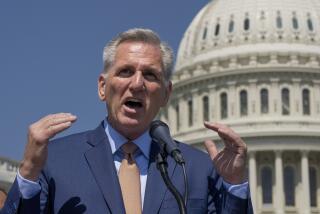Treasury May Resume Sales of 30-Year Bonds
- Share via
The U.S. stopped selling the long-term securities in 2001 but now needs to finance record deficits.
The 30-year Treasury bond may be making a comeback.
The Bush administration, which stopped selling the bonds in October 2001, said Wednesday that it was seriously considering bringing them back as the government faces the need to finance record budget deficits.
Bond traders hailed the announcement, saying the action was overdue and would provide investors with a fresh supply of long-term bonds.
But the price of existing 30-year bonds, which continue to be traded, plunged Wednesday immediately after the announcement.
Officials said that drop in price, which pushed the yield of the bonds higher, was probably only a temporary reaction to the prospect that the supply of the bonds would soon be increasing. The price of the bond fell by $20.31 per $1,000, pushing the yield to 4.59%, up from 4.48% on Tuesday.
The government stopped selling the 30-year bond in 2001, the fourth and last year the United States ran a budget surplus. It was a time when government officials believed they did not need as many different types of securities, because borrowing needs were falling.
When President Bush took office, the government was projecting that budget surpluses would total $5.6 trillion over the next 10 years. Those surpluses never happened, the victim of the 2001 recession, the Iraq war, an offensive against terrorism, and Bush’s tax cuts.
Instead, the government recorded record budget deficits in 2003 and 2004. The administration is projecting another record deficit of $427 billion this year, although private forecasters believe the red ink will be lower.
Timothy S. Bitsberger, assistant Treasury secretary for financial markets, said that after taking public comments, the department would decide whether to bring back the bond Aug. 3, the date the government will announce its borrowing plans for that quarter.
If the answer is yes -- and private market officials believe it will be -- then the first auction will take place in February, with auctions held twice a year, Bitsberger told reporters.
If the auctions are held next year, he said, the amount of 30-year bonds offered for sale will be $20 billion to $30 billion.
The Treasury started selling the 30-year bond in 1977 as rising deficits made it necessary for the government to look for new ways to package the debt.
Micah S. Green, president of the Bond Market Assn., praised the government’s announcement, saying a survey done by the association indicated that there would be heavy demand.
“Investors such as pension funds and insurance companies have a strong appetite for long-dated securities,” Green said.
Analysts noted that a U.S. move would follow those of other countries to meet such demand. France this year auctioned a 50-year bond.
“The market wants a 30-year bond,” said David Wyss, chief economist at Standard & Poor’s.
More to Read
Inside the business of entertainment
The Wide Shot brings you news, analysis and insights on everything from streaming wars to production — and what it all means for the future.
You may occasionally receive promotional content from the Los Angeles Times.










